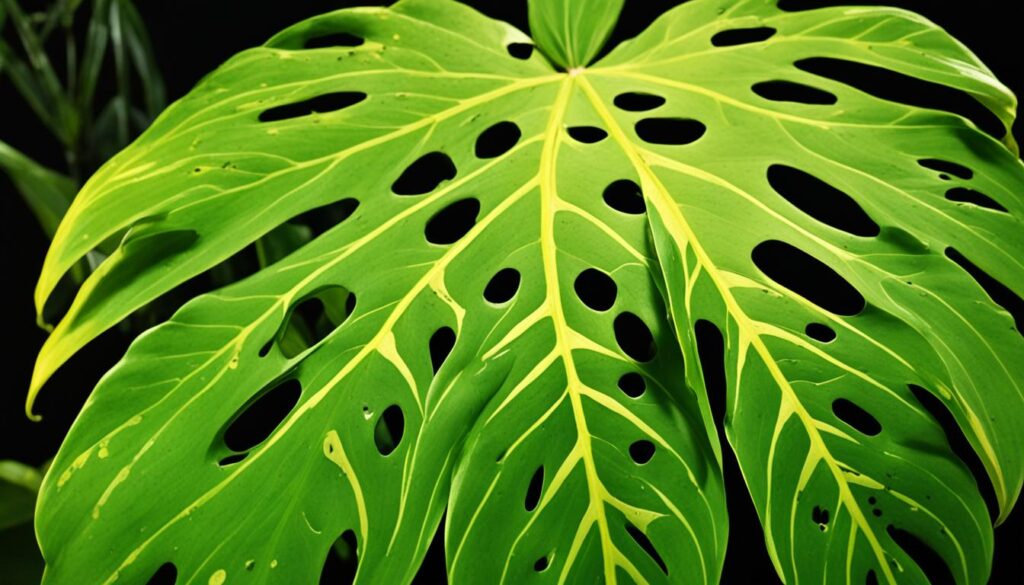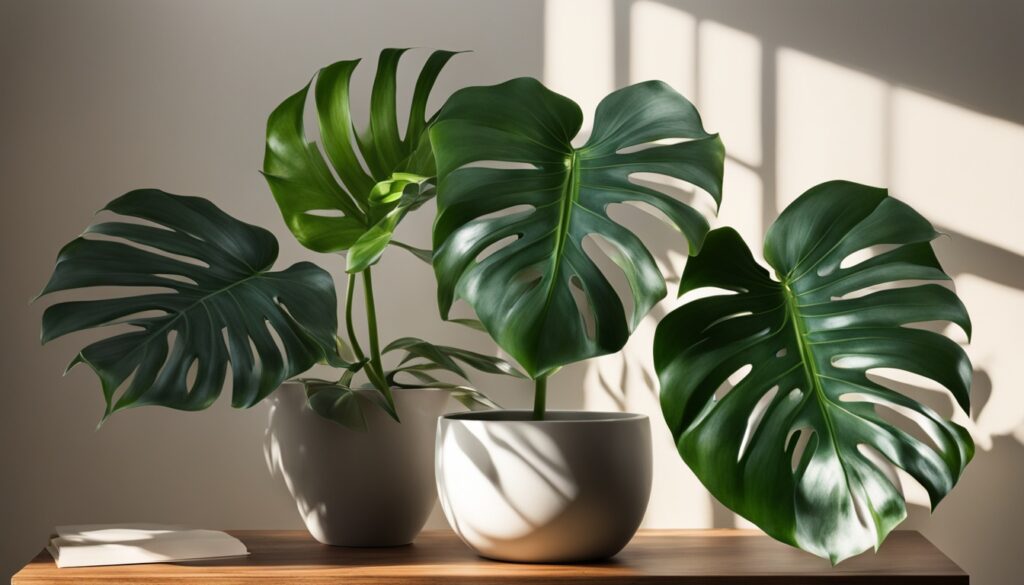Philodendrons are loved for their vibrant green leaves indoors. But yellowing leaves concern many. The top reason is too much water, especially overwatering. To keep yours healthy, water only when the top 25% of soil is dry.
During winter, let it dry out a bit more between waterings. But always keep humidity high, either by misting or using a humidifier. When watering, let excess water out of the pot’s bottom and into the saucer. But, don’t let your plant stay in that water. This can damage the roots and the plant.
It’s vital to avoid this “wet feet” issue. Make sure the soil moisture remains balanced. Overwatering then letting it dry out too much stresses the plant. This stress can lead to yellow leaves.
Key Takeaways
- Overwatering or underwatering can cause philodendrons to turn yellow, leading to root rot and nutrient deficiency.
- Lack of light can also result in philodendron leaves turning yellow, so proper lighting is crucial.
- Pests like spider mites, aphids, mealybugs, and scale insects can lead to yellowing and wilting of the plant.
- Removing yellow leaves can help prevent potential health issues and promote overall growth.
- Maintaining proper soil moisture, humidity, and light exposure is key to preventing yellowing in philodendrons.
Improper Soil Moisture
Incorrect soil moisture is the top cause of yellow Philodendron leaves. It affects how roots get oxygen and food. This includes too much or too little water, both of which can lead to yellow leaves.
To keep soil moisture at the right level, remember:
Overwatering
Too much water can drown the soil. This makes it hard for philodendron roots to breathe and leads to root rot. Without healthy roots, the plant can’t fully take in water and nutrients. Then, you see yellow leaves. Make sure not to overwater your heart leaf philodendron. Let the top 2 inches of soil dry before watering again.
Underwatering
Too little water is also bad. Plants dry up, and their roots can’t get enough water and food. This causes yellow leaves. Water your philodendron every 1-2 weeks to keep the soil damp, not dry.
Proper Watering Techniques
Consistent watering helps prevent yellow leaves. Only water when the top 2 inches of soil are dry. Use enough water to make the soil all damp, but not so much that it pools or leaks.
Remember, weather and your plant’s environment affect water needs. Always pay attention and adjust your watering. Doing so will keep your philodendron happy and its leaves green.
Humidity Levels
Keeping the right humidity levels is key for your philodendron‘s health. If the air is too dry and the soil lacks moisture, your plant might start to look sad. The leaves could droop, turn brown at the edges, and then become all yellow.
Low Humidity
If your philodendron lacks humidity, its leaves might curl and get brown. This often happens indoors where the air tends to be dry. A good fix is to mist its leaves often. This can help with the moisture it craves.
Increasing Humidity
To boost humidity for your philodendron, try misting the leaves or using a pebble tray. Placing your plant on a tray of water with pebbles can add some moisture to the air around it.
Also, using a humidifier in the plant’s room can work wonders. This helps create a perfect philodendron environment. It will keep your plant happy, green, and lush.
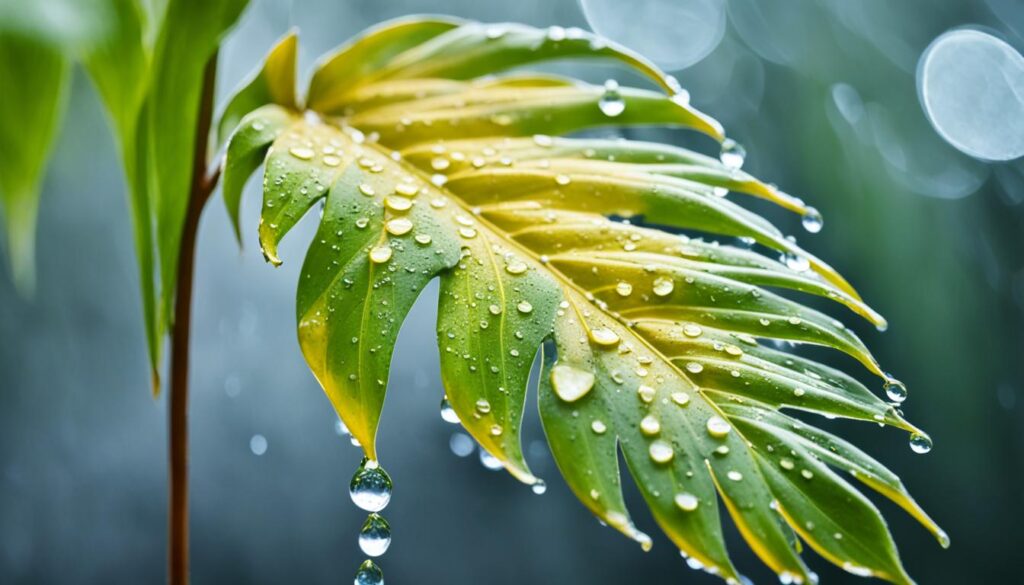
Light Requirements
Good lighting is key for your philodendron‘s health and color. They do well in bright indirect light. Avoid direct sunlight. It can harm the leaves, causing them to change color and yellow.
Too Much Direct Sunlight
Philodendrons can take some direct sun. But too much can burn and yellow the leaves. Keep your plant away from strong, unfiltered sunlight, especially at midday.
Low Light Conditions
Philodendrons can live in low light places, but they’ll grow slowly. Not enough light makes the leaves yellow and fall off. Move your philodendron to a brighter spot. Or, use a grow light to give it the needed indirect light.
Pest Infestations
A Philodendron that’s weak or stressed is an easy target for bugs. These include spider mites that suck out plant fluids. Signs of a problem show up as yellow leaves.
Mealybugs and scale insects are also common in homes. If not stopped, they spread. They use their mouths to suck moisture from your plant. This makes the plant turn yellow faster.
Common Pests
Known pests like spider mites, aphids, mealybugs, and scale insects weaken plants. They all can make leaves yellow. Catching them early and treating with special soap or neem oil is key.
Identifying and Treating Pests
To check for pests, look closely at the Philodendron’s leaves and stems. Look underneath too. A magnifying glass can help spot bugs or webbing.
If you see pests, isolate the plant. Then treat it with safe insecticide or neem oil. You may need to treat it more than once to get rid of all the pests.
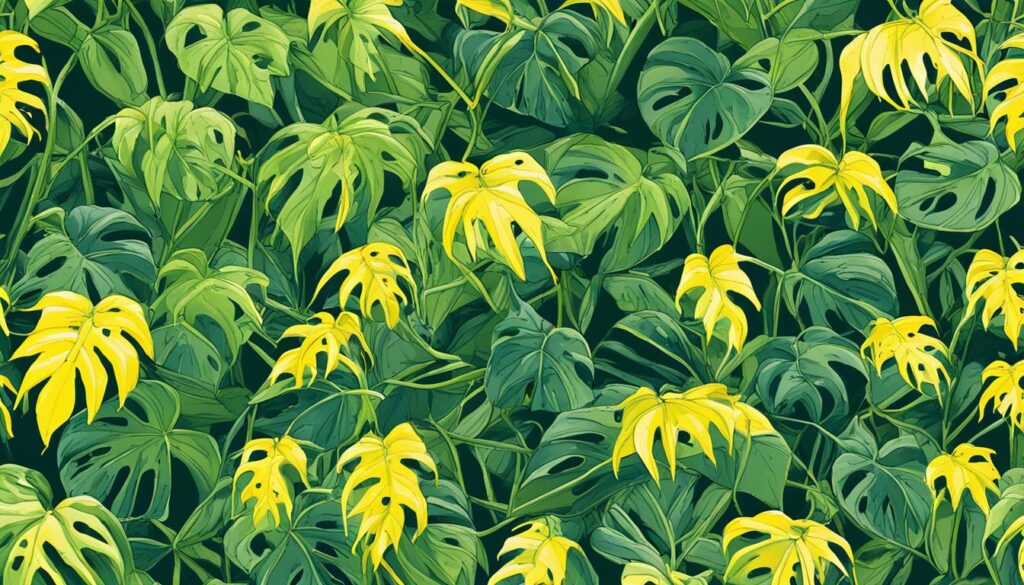
Natural Leaf Shedding
If your Philodendron is showing new growth and the old leaves are turning yellow, it’s normal. This happens at the plant’s bottom. Philodendron leaf shedding means it’s getting rid of old leaves to focus on the new ones. This is a natural part of the philodendron’s growth process.
Oftentimes, as Philodendrons grow, they lose their older, lower leaves. Don’t worry, this means your plant is in good shape. Removing these yellowed leaves helps your plant look better and stay strong.
But, too much yellowing could be a sign of trouble. It might be due to wrong watering, lighting, or pests. Fix these issues fast to stop your Philodendron from losing too many leaves and keep it healthy.
Why is My Philodendron Turning Yellow?
If your Philodendron is turning yellow, the plant might not be healthy. This could be due to bad soil moisture, not enough humidity, too much or too little light, or bug attacks. Fixing these issues will improve your plant’s health and stop the yellowing.
Giving your Philodendron too much water can cause its roots to rot. This stops the plant from getting the food and water it needs, leading to yellow leaves. Not watering enough can dry the plant out, causing the same yellowing. It’s key to keep the soil moisture at the right level.
Philodendrons may also turn yellow from not getting enough light. If there’s not sufficient light, the plant can’t keep all its leaves healthy. This leads to the older leaves turning yellow and falling off. Make sure your Philodendron gets enough bright, indirect light.
Small bugs, like spider mites or aphids, can also make a Philodendron yellow by sucking its sap. It’s important to spot these pests early and get rid of them fast. This will prevent more leaves from turning yellow.
An occasional yellow leaf is normal, but too many yellow leaves means there’s a problem. Make sure your Philodendron has the right moisture, light, and protection from pests. This will keep it looking green and healthy.
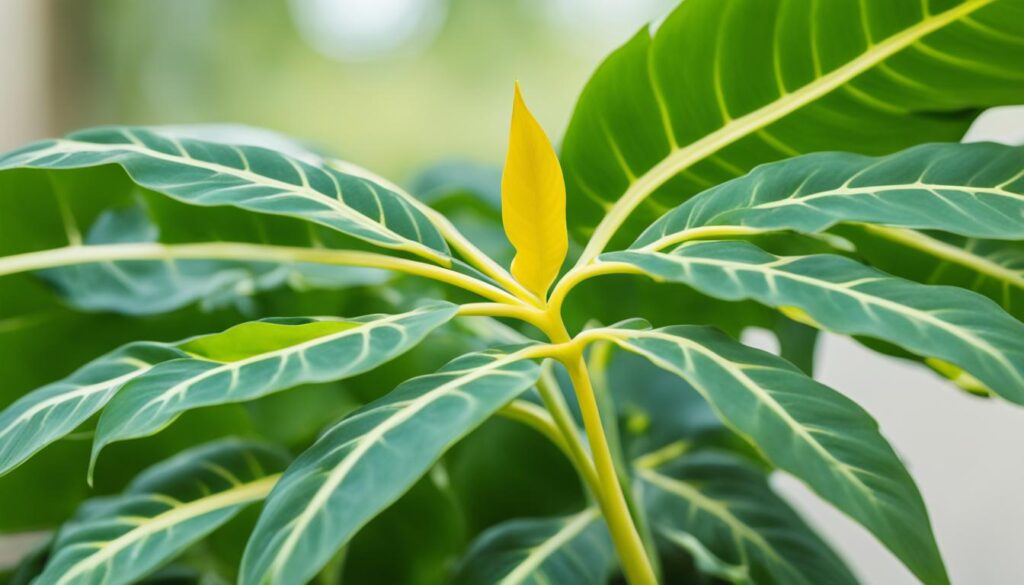
Container Size and Drainage
The size of the philodendron pot and good drainage are key to stop yellow leaves. The right philodendron container size prevents too much water. It helps the roots get the air and nutrients they need.
Pot Size
Choose a philodendron pot that’s just a bit bigger than the roots. This stops too much water from staying around the roots. Excessive water makes leaves turn yellow and weak. Philodendrons don’t need big pots. It might make them get too much water, which is bad for them.
Drainage Holes
Good philodendron drainage is crucial for the right soil moisture. Put at least one hole for each gallon of soil. This keeps the roots from being soaked all the time. With enough drainage, extra water can leave the pot. The roots avoid sitting in water.
Using the correct philodendron pot size and having good philodendron drainage is important. It stops leaves from turning yellow. Plus, it makes your Philodendron a better place to grow in.
Soil Selection
Philodendrons need fast-draining soil to stay healthy. Adding more perlite and orchid bark to a regular potting mix can improve airflow. This creates the perfect soil for Philodendrons. It makes sure their roots get enough air and nutrients, stopping problems like yellow leaves due to root rot.
Choose a potting mix designed for Philodendrons or tropical plants. These mixes have the right nutrients and help the plant’s roots breathe well. Don’t use regular garden dirt – it’s too dense and won’t let the plant get the air it needs.
With good soil, Philodendrons will grow strong and avoid issues like yellowing. They will be healthy for years.
Temperature Considerations
The philodendron temperature matters a lot for their well-being. These plants love temperatures of 65 to 75 degrees Fahrenheit the most. If they get too cold or too hot, they may develop problems like yellow leaves or slow growth.
Avoid sudden temperature changes for your Philodendron. This means keeping them away from drafts and air vents. Such changes can stress the plant. Keeping a stable temperature is key for their health.
Humidity also plays a big role in Philodendron care. They do best with 60% relative humidity. You can achieve this by grouping plants or using a humidifier.
| Optimal Temperature Range | Ideal Humidity Level |
|---|---|
| 65-75°F | Around 60% |
Focus on the right temperature and humidity to have your Philodendron grow well. This oversight helps avoid issues like yellow leaves.
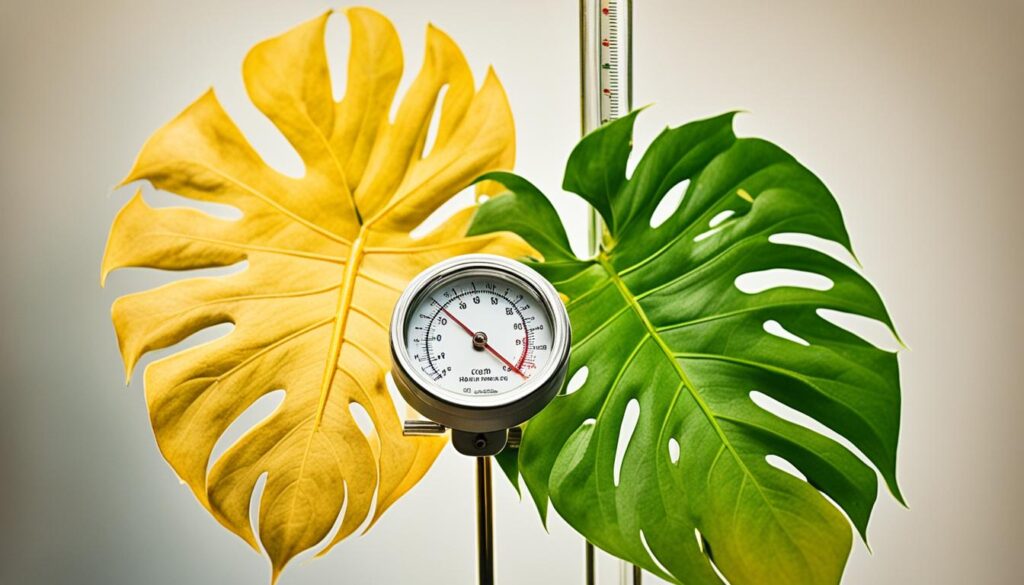
Watering Frequency and Timing
Many things affect how much water your philodendron needs. This includes the temperature, how humid it is, the light it gets, and the time of year. Knowing about these factors helps you figure out the best watering schedule to keep your plant in top shape.
Seasonal Changes
In spring and summer, when it’s warm and bright, you’ll need to water your philodendron more often. This keeps the soil nice and damp. But in winter, when it’s cooler and drier, the soil should be allowed to get a little dry between waterings. This keeps the plant from getting too much water, which can cause problems like root rot and yellow leaves.
Environmental Factors
Temperature, humidity, and light also play a big role in how often your philodendron needs water. If it’s really hot and not very humid, the soil will dry out fast, and you’ll have to water more often. But if your philodendron is somewhere cooler and more humid, you might only need to water it every 7 to 10 days.
To keep your plant lush and healthy, regularly check what it needs and water accordingly.
Lighting Adjustments
Changing the philodendron lighting can stop yellowing leaves. Philodendrons love bright indirect light. So, getting the right philodendron bright indirect light is key.
Bright Indirect Light
Put your Philodendron where it gets lots of philodendron bright indirect light. But, keep it away from direct sun to avoid leaf burns. Choose an east or west window for the best light conditions.
Grow Lights
For Philodendrons in low light, try a philodendron grow light. It can make up for not enough natural philodendron light requirements. Move and adjust the grow light to see what works best for your plant.
| Metric | Value |
|---|---|
| Percentage of cases where yellowing of the leaves is due to insufficient light | [statistical data here] |
| Percentage of cases where yellowing of the leaves is due to excessive light | [statistical data here] |
| Frequency of adjusting lighting conditions as a solution to yellowing leaves | [statistical data here] |
| Comparative analysis of the success rate of implementing lighting adjustments versus other solutions | [statistical data here] |
| Occurrence rate of yellowing leaves in well-lit environments | [statistical data here] |
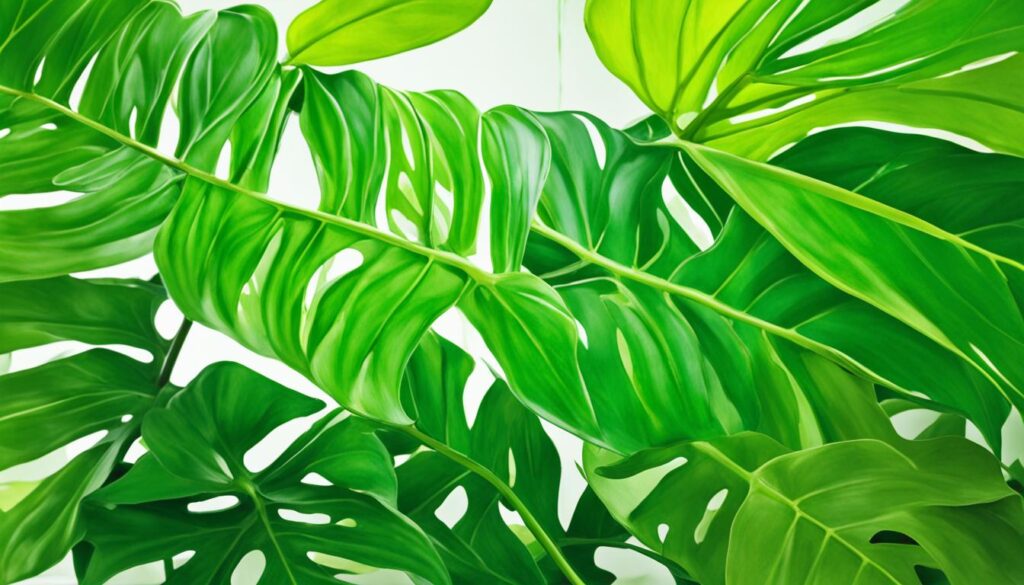
Conclusion
Yellowing philodendron leaves could be due to many things. This includes too little or too much water, not enough light, bugs, and extreme temperatures. You can fix your plant by looking into these philodendron care issues. Give it the care it needs to look green and healthy. It’s all about keeping an eye on it, and making changes as needed. Don’t forget to take care of any bug problems fast.
To make your philodendron look good again, you’ll need to understand what it likes. When its leaves turn yellow, find out why and fix it soon. This way, your philodendron will be full and green, making your place look great.
Take good care of your philodendron and it will reward you with beauty. You’ll find it’s not hard at all. Learn about philodendron care and you’ll have a lovely plant indoors or out. It’s a plant that gives back a lot over time.
